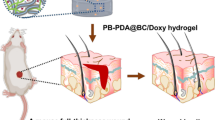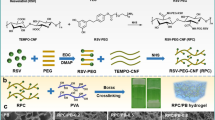Abstract
Adhesive hydrogel has drawn great attention for wide applications in wound healing owing to its excellent biocompatibility and lasting adhesiveness. However, traditional adhesive hydrogels only keep the wound moist to promote wound healing. It is still imperative to fabricate adhesive hydrogels that exhibit efficient antibacterial ability, active driving dynamic wound closure, and reactive oxygen species (ROS) scavenging together with excellent mechanical properties. Here, a novel hydrogel based on poly(N-isopropyl acrylamide) (PNIPAAm), a thermoresponsive polymer, and tannic acid (TA)-Ag nanoparticles (TA-Ag NPs) exhibiting active contraction, tissue adhesion, anti-inflammatory and antibacterial functions was developed. TA-Ag dispersed in the hydrogel not only functioned as the catalyst to polymerize the reaction but also provided additional anti-inflammatory and antibacterial properties. Besides, tannic acid containing catechol groups endowed the hydrogel with adhesive ability. More interestingly, the obtained hydrogel exhibited the thermoresponsive shrinkage ability, which could mechanically drive wound closure due to the presence of PNIPAAm network. In vivo mouse full-thickness skin defect model demonstrated that this actively contractible and antibacterial hydrogel is a promising dressing to improve wound healing process by accelerating tissue regeneration and preventing bacterial infection. Therefore, this multi-functional adhesive hydrogel developed here may provide a new possibility for wound healing.

Similar content being viewed by others
References
Mirani, B.; Pagan, E.; Currie, B.; Siddiqui, M. A.; Hosseinzadeh, R.; Mostafalu, P.; Zhang, Y. S.; Ghahary, A.; Akbari, M. An advanced multifunctional hydrogel-based dressing for wound monitoring and drug delivery. Adv. Healthcare Mater. 2017, 6, 1700718.
Lim, H. W.; Kohli, I.; Ruvolo, E.; Kolbe, L.; Hamzavi, I. H. Impact of visible light on skin health: The role of antioxidants and free radical quenchers in skin protection. J. Am. Acad. Dermatol. 2022, 86, S27–S37.
Fan, Z. J.; Liu, B.; Wang, J. Q.; Zhang, S. Y.; Lin, Q. Q.; Gong, P. W.; Ma, L. M.; Yang, S. R. A novel wound dressing based on Ag/graphene polymer hydrogel: Effectively kill bacteria and accelerate wound healing. Adv. Funct. Mater. 2014, 24, 3933–3943.
Armstrong, D. G.; Boulton, A. J. M.; Bus, S. A. Diabetic foot ulcers and their recurrence. N. Engl. J. Med. 2017, 376, 2367–2375.
Bowling, F. L.; Rashid, S. T.; Boulton, A. J. M. Preventing and treating foot complications associated with diabetes mellitus. Nat. Rev. Endocrinol. 2015, 11, 606–616.
Blacklow, S. O.; Li, J.; Freedman, B. R.; Zeidi, M.; Chen, C.; Mooney, D. J. Bioinspired mechanically active adhesive dressings to accelerate wound closure. Sci. Adv. 2019, 5, eaaw3963.
Zhao, H.; Huang, J.; Li, Y.; Lv, X. J.; Zhou, H. T.; Wang, H. R.; Xu, Y. Y.; Wang, C.; Wang, J.; Liu, Z. ROS- scavenging hydrogel to promote healing of bacteria infected diabetic wounds. Biomaterials 2020, 258, 120286.
Li, Y. S.; Wang, X.; Fu, Y. N.; Wei, Y.; Zhao, L. Y.; Tao, L. Self-adapting hydrogel to improve the therapeutic effect in wound-healing. ACS Appl. Mater. Interfaces 2018, 10, 26046–26055.
Jin, S. B.; Choi, H.; Seong, D.; You, C. L.; Kang, J. S.; Rho, S.; Lee, W. B.; Son, D.; Shin, M. Injectable tissue prosthesis for instantaneous closed-loop rehabilitation. Nature 2023, 623, 58–65.
Zhao, Y.; Song, S. L.; Ren, X. Z.; Zhang, J. M.; Lin, Q.; Zhao, Y. L. Supramolecular adhesive hydrogels for tissue engineering applications. Chem. Rev. 2022, 122, 5604–5640.
Chen, Q.; Wang, C.; Zhang, X. D.; Chen, G. J.; Hu, Q. Y.; Li, H. J.; Wang, J. Q.; Wen, D.; Zhang, Y. Q.; Lu, Y. F. et al. In situ sprayed bioresponsive immunotherapeutic gel for post-surgical cancer treatment. Nat. Nanotechnol. 2019, 14, 89–97.
Hong, Y.; Zhou, F. F.; Hua, Y. J.; Zhang, X. Z.; Ni, C. Y.; Pan, D. H.; Zhang, Y. Q.; Jiang, D. M.; Yang, L.; Lin, Q. N. et al. A strongly adhesive hemostatic hydrogel for the repair of arterial and heart bleeds. Nat. Commun. 2019, 10, 2060.
Hu, J. Y.; Wei, T.; Zhao, H.; Chen, M. C.; Tan, Y. J.; Ji, Z. X.; Jin, Q. T.; Shen, J. J.; Han, Y. K.; Yang, N. L. et al. Mechanically active adhesive and immune regulative dressings for wound closure. Matter 2021, 4, 2985–3000.
Nodder, S.; Martin, P. Wound healing in embryos: a review. Anat. Embryol. (Berl). 1997, 195, 215–228.
Mahou, R.; Zhang, D. K. Y.; Vlahos, A. E.; Sefton, M. V. Injectable and inherently vascularizing semi-interpenetrating polymer network for delivering cells to the subcutaneous space. Biomaterials 2017, 131, 27–35.
Yannas, I. V.; Burke, J. F.; Orgill, D. P.; Skrabut, E. M. Wound tissue can utilize a polymeric template to synthesize a functional extension of skin. Science 1982, 215, 174–176.
Shang, Y. N.; Wang, Z. Y.; Zhang, R. S.; Li, X. X.; Zhang, S. H.; Gao, J.; Li, X. Y.; Yang, Z. M. A novel thermogel system of self-assembling peptides manipulated by enzymatic dephosphorylation. Chem. Commun. 2019, 55, 5123–5126.
Wang, Z. L.; Liu, L. L.; Bu, W. H.; Zheng, M. D.; Jin, N. Q.; Zhang, K.; Xu, X. W.; Zhou, D.; Yang, B.; Sun, H. C. Carbon dots induce epithelial-mesenchymal transition for promoting cutaneous wound healing via activation of TGF-β/p38/snail pathway. Adv. Funct. Mater. 2020, 30, 2004886.
Lu, X. L.; Shi, S. J.; Li, H. M.; Gerhard, E.; Lu, Z. H.; Tan, X. Y.; Li, W. L.; Rahn, K. M.; Xie, D. H.; Xu, G. D. et al. Magnesium oxide-crosslinked low-swelling citrate-based mussel-inspired tissue adhesives. Biomaterials 2020, 232, 119719.
Grice, E. A.; Snitkin, E. S.; Yockey, L. J.; Bermudez, D. M.; NISC Comparative Sequencing Program; Liechty, K. W.; Segre, J. A.; Mullikin, J.; Blakesley, R.; Young, A. et al. Longitudinal shift in diabetic wound microbiota correlates with prolonged skin defense response. Proc. Natl. Acad. Sci. USA 2010, 107, 14799–14804.
Eming, S. A.; Martin, P.; Tomic-Canic, M. Wound repair and regeneration: Mechanisms, signaling, and translation. Sci. Transl. Med. 2014, 6, 265sr6.
Dantas, G.; Sommer, M. O. A.; Oluwasegun, R. D.; Church, G. M. Bacteria subsisting on antibiotics. Science 2008, 320, 100–103.
Cook, M. A.; Wright, G. D. The past, present, and future of antibiotics. Sci. Transl. Med. 2022, 14, eabo7793.
Gupta, A.; Mumtaz, S.; Li, C. H.; Hussain, I.; Rotello, V. M. Combatting antibiotic-resistant bacteria using nanomaterials. Chem. Soc. Rev. 2019, 48, 415–427.
Guo, Y. H.; Dundas, C. M.; Zhou, X. Y.; Johnston, K. P.; Yu, G. H. Molecular engineering of hydrogels for rapid water disinfection and sustainable solar vapor generation. Adv. Mater. 2021, 33, 2102994.
Tu, C. X.; Lu, H. D.; Zhou, T.; Zhang, W. Y.; Deng, L. W.; Cao, W. B.; Yang, Z. J.; Wang, Z. L.; Wu, X. Y.; Ding, J. et al. Promoting the healing of infected diabetic wound by an anti-bacterial and Nanoenzyme-containing hydrogel with inflammation-suppressing, ROS-scavenging, oxygen and nitric oxide-generating properties. Biomaterials 2022, 286, 121597.
Andres, Y.; Giraud, L.; Gerente, C.; Le Cloirec, P. Antibacterial effects of chitosan powder: Mechanisms of action. Environ. Technol. 2007, 28, 1357–1363.
Afewerki, S.; Wang, X. C.; Ruiz-Esparza, G. U.; Tai, C. W.; Kong, X. Y.; Zhou, S. Y.; Welch, K.; Huang, P.; Bengtsson, R.; Xu, C. et al. Combined catalysis for engineering bioinspired, lignin-based, long-lasting, adhesive, self-mending, antimicrobial hydrogels. ACS Nano 2020, 14, 17004–17017.
Ahmadian, Z.; Correia, A.; Hasany, M.; Figueiredo, P.; Dobakhti, F.; Eskandari, M. R.; Hosseini, S. H.; Abiri, R.; Khorshid, S.; Hirvonen, J. et al. A hydrogen-bonded extracellular matrix-mimicking bactericidal hydrogel with radical scavenging and hemostatic function for pH-responsive wound healing acceleration. Adv. Healthcare Mater. 2021, 10, 2001122.
Chen, C. Y.; Yin, H.; Chen, X.; Chen, T. H.; Liu, H. M.; Rao, S. S.; Tan, Y. J.; Qian, Y. X.; Liu, Y. W.; Hu, X. K. et al. Ångstrom-scale silver particle-embedded carbomer gel promotes wound healing by inhibiting bacterial colonization and inflammation. Sci. Adv. 2020, 6, eaba0942.
Liang, Y. Q.; Li, Z. L.; Huang, Y.; Yu, R.; Guo, B. L. Dual-dynamic-bond cross-linked antibacterial adhesive hydrogel sealants with on-demand removability for post-wound-closure and infected wound healing. ACS Nano 2021, 15, 7078–7093.
Li, X. L.; Gong, N. Q.; Tian, F. L.; Zhang, S. K.; Zhang, Y. X.; Wang, Y. F.; Qing, G.; Wang, Y. C.; Li, F. Z.; Xu, Y. H. et al. Suppression of cytokine release syndrome during CAR-T-cell therapy via a subcutaneously injected interleukin-6-adsorbing hydrogel. Nat. Biomed. Eng. 2023, 7, 1129–1141.
He, Y. T.; Li, Q.; Chen, P. E.; Duan, Q. X.; Zhan, J. M.; Cai, X. H.; Wang, L. Y.; Hou, H. H.; Qiu, X. Z. A smart adhesive Janus hydrogel for non-invasive cardiac repair and tissue adhesion prevention. Nat. Commun. 2022, 13, 7666.
Choi, H.; Lee, J. H.; Kim, Y. R.; Song, D.; Kang, S. W.; Lee, S. S.; Kang, Y. S. Tetrathiafulvalene as an electron acceptor for positive charge induction on the surface of silver nanoparticles for facilitated olefin transport. Chem. Commun. 2014, 50, 3194–3196.
Wu, F.; Pang, Y.; Liu, J. Y. Swelling- strengthening hydrogels by embedding with deformable nanobarriers. Nat. Commun. 2020, 11, 4502.
Burke, G.; Devine, D. M.; Major, I. Effect of stereolithography 3D printing on the properties of PEGDMA hydrogels. Polymers (Basel) 2020, 12, 2015.
Zhou, L.; Fan, L.; Yi, X.; Zhou, Z. N.; Liu, C.; Fu, R. M.; Dai, C.; Wang, Z. G.; Chen, X. X.; Yu, P. et al. Soft conducting polymer hydrogels cross-linked and doped by tannic acid for spinal cord injury repair. ACS Nano 2018, 12, 10957–10967.
Molyneux, P. The use of the stable free radical diphenylpicrylhydrazyl (DPPH) for estimating antioxidant. Songklanakarin J. Sci. Technol. 2004, 26, 211–219.
Baliyan, S.; Mukherjee, R.; Priyadarshini, A.; Vibhuti, A.; Gupta, A.; Pandey, R. P.; Chang, C-M. Determination of antioxidants by DPPH radical scavenging activity and quantitative phytochemical analysis of ficus religiosa. Molecules. 2022, 27, 1326.
Sahel, K.; Elsellami, L.; Mirali, I.; Dappozze, F.; Bouhent, M.; Guillard, C. Hydrogen peroxide and photocatalysis. Appl. Catal. B Environ. 2016, 188, 106–112.
Carter, W. O.; Naryanan, P. K.; Robinson, J. P. Intracellular hydrogen peroxide and superoxide anion detection in endothelial cells. J Leukocyte Biol 1994, 55, 253–258.
Aranda, A.; Sequedo, L.; Tolosa, L.; Quintas, G.; Burello, E.; Castell, J. V.; Gombau, L. Dichloro-dihydro- fluorescein diacetate (DCFH-DA) assay: A quantitative method for oxidative stress assessment of nanoparticle-treated cells. Toxicol. Vitro 2013, 27, 954–963.
Hwang, J.; Huang, Y. F.; Burwell, T. J.; Peterson, N. C.; Connor, J.; Weiss, S. J.; Yu, S. M.; Li, Y. In situ imaging of tissue remodeling with collagen hybridizing peptides. ACS Nano 2017, 11, 9825–9835
De Oliveira, S.; Rosowski, E. E.; Huttenlocher, A. Neutrophil migration in infection and wound repair: Going forward in reverse. Nat. Rev. Immunol. 2016, 16, 378–391.
Rehak, L.; Giurato, L.; Meloni, M.; Panunzi, A.; Manti, G. M.; Uccioli, L. The immune-centric revolution in the diabetic foot: Monocytes and lymphocytes role in wound healing and tissue regeneration—a narrative review. J. Clin. Med. 2022, 11, 889.
Ley, K.; Laudanna, C.; Cybulsky, M. I.; Nourshargh, S. Getting to the site of inflammation: The leukocyte adhesion cascade updated. Nat. Rev. Immunol. 2007, 7, 678–689.
Meng, Y.; Chen, L. J.; Chen, Y.; Shi, J. Y.; Zhang, Z.; Wang, Y. W.; Wu, F.; Jiang, X. W.; Yang, W.; Zhang, L. et al. Reactive metal boride nanoparticles trap lipopolysaccharide and peptidoglycan for bacteria-infected wound healing. Nat. Commun. 2022, 13, 7353.
Acknowledgements
This article was partially supported by the National Research Programs of China (Nos. 2020YFA0211100, and 2022YFA1206500), the National Natural Science Foundation of China (Nos. 52250002, and 52325106), Suzhou Key Laboratory of Nanotechnology and Biomedicine, Collaborative Innovation Center of Suzhou Nano Science and Technology, and the 111 Program from the Ministry of Education of China.
Author information
Authors and Affiliations
Corresponding authors
Electronic Supplementary Material
Rights and permissions
About this article
Cite this article
Ji, Z., Wei, T., Zhu, J. et al. Actively contractible and antibacterial hydrogel for accelerated wound healing. Nano Res. (2024). https://doi.org/10.1007/s12274-024-6674-6
Received:
Revised:
Accepted:
Published:
DOI: https://doi.org/10.1007/s12274-024-6674-6




